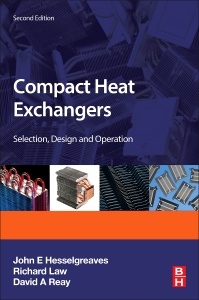Description
Compact Heat Exchangers (2nd Ed.)
Selection, Design and Operation
Authors: Hesselgreaves J.E., Law Richard, Reay David
Language: English
Subject for Compact Heat Exchangers:
127.94 €
In Print (Delivery period: 14 days).
Add to cartSupport: Print on demand
Description
/li>Contents
/li>Readership
/li>Biography
/li>Comment
/li>
Compact Heat Exchangers: Selection, Design, and Operation, Second Edition, is fully revised to present the most recent and fundamental ideas and industrial concepts in compact heat exchanger technology. This complete reference compiles all aspects of theory, design rules, operational issues, and the most recent developments and technological advancements in compact heat exchangers.
New to this edition is the inclusion of micro, sintered, and porous passage description and data, electronic cooling, and an introduction to convective heat transfer fundamentals. New revised content provides up-to-date coverage of industrially available exchangers, recent fouling theories, and reactor types, with summaries of off-design performance and system effects and installations issues in, for example, automobiles and aircraft.
Hesselgreaves covers previously neglected approaches, such as the Second Law (of Thermodynamics), pioneered by Bejan and co-workers. The justification for this is that there is increasing interest in life-cycle and sustainable approaches to industrial activity as a whole, often involving exergy (Second Law) analysis. Heat exchangers, being fundamental components of energy and process systems, are both savers and spenders of energy, according to interpretation.
1. Introduction 2. Industrial Compact Exchangers 3. The Heat Exchanger as Part of a System: Exergetic (Second Law) Analysis 4. Surface Comparisons, Size, Shape and Weight Relationships 5. Aspects of Flow and Convective Heat Transfer Fundamentals for Compact Surfaces 6. Surface Types and Correlations 7. Thermal Design 8. Compact Heat Exchangers in Practice
practicing and research engineers in user, contractor and manufacturing sectors of industry. Researchers and graduate students in academia
Richard Law is a Research Associate in the School of Chemical Engineering and Advanced Materials at Newcastle University, UK. His main research areas are heat transfer enhancement, heat exchanger design, heat pumps, power cycles and industrial waste heat recovery.
Professor Reay manages David Reay & Associates, UK, and he is a Visiting Professor at Northumbria University, Emeritus Professor at Newcastle University, and Honorary Professor Brunel University London, UK. His main research interests are compact heat exchangers, process intensification, and heat pumps. He is also Editor-in-Chief of Thermal Science and Engineering Progress and Associate Editor of the International Journal of Thermofluids, both are published by Elsevier. Prof. Reay is the Author/Co-author of eight other books.
- Contains revised content, covering industrially available exchangers, recent fouling theories, and reactor types
- Includes useful comparisons throughout with conventional heat exchangers to emphasize the benefits of CPHE applications
- Provides a thorough system view from commissioning, operation, maintenance, and design approaches to reduce fouling and fouling factors
- Compiles all aspects of theory, design rules, operational issues, and the most recent developments and technological advancements in compact heat exchangers
These books may interest you

Heat Exchanger Design Handbook 152.20 €

Heat Exchanger Design Handbook 293.12 €


